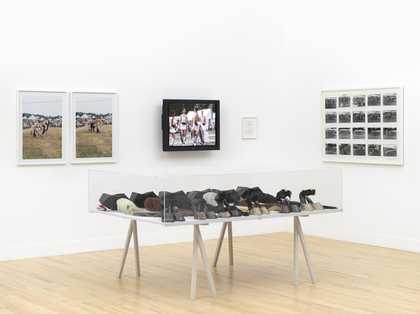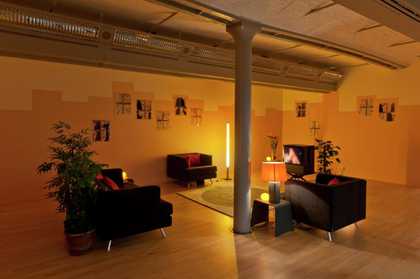Rose English: The installation of Quadrille reflects a performance I made in 1975. The performance was for six dancers dressed in costumes that resembled horse hooves and tails. They performed in the dressage arena at a show in Southampton.
Voiceover: Rose English describes the evolution of her artwork Quadrille as three versions. The original installation with one costume. The live performance. And the installation in Tate’s collection. Each version forms a part of the life of the artwork.
English: I started by making a prototype costume, the first pair of shoes, and also a tail, and I made them to fit myself so that I could see what it was like. And I exhibited those at the Women’s Free Art Alliance. I believe at the end of 1974, so about 6 months before I made the performance.
There is actually such a thing with horse dressage events called a quadrille where the horses perform a synchronized display.
There was also a whole repertoire of movements that were much more naturalistic. When you often see horses at rest together, they rest with their forehead pressing against each other as if communicating some deep meaning between each other.
Voiceover: The performance of Quadrille was a bold and challenging intervention to a horse show. It can also be read as a rather sexy and provocative class critique.
English: I was wanting to draw people's attention to this extraordinarily hidden, but also completely hiding in plain air, highly codified, highly restricted, deeply conservative world.
As the dancers came out of a little tent that they'd been changing in, the organizer saw their costumes. She refused to let the event go ahead. I explained that it had been nearly 18 months, two years' work and that we'd all assembled and we were ready to go. Eventually, she backed down.
It was then performed the second time on the same day, only twice in the same day it was ever performed. And the audience there were given no information about what they were about to see, and just sat there, patiently watching as if it was the police dog display team, or I don't know, the parachute regiment or any of the other events that were happening.
I don't think anybody necessarily appreciated my interest in the correlation between dressage and ballet, and its origin and court spectacle. I think they just thought that it was an assault. It wasn't intended to be an assault, a critique perhaps, but not an assault.
That was a very important lesson to me as a young artist. I thought that the world or the equestrian event would understand what I was doing, but no.
Voiceover: After the event, English kept and carefully stored the costumes, and took them with her as she moved from one derelict squat house to another throughout the 1970s. But she faced new challenges when creating the third version of Quadrille in 2013.
English: I was very conscious of the fact that I was using the parts of deceased animals. It felt that if I was to do so I needed to honor them by how I did it.
40 years on, I was working on the installation Quadrille, the work that we see here, the costumes required conservation. I spoke to a conservator called Julia Parks Newman who specialises, particularly in organics, feather, fur, hair.
We really discussed at some length how to find a sweet spot between making them look like they were new and actually acknowledging the fact that they were costumes that were worn in a performance event from 1975, and to honour their history.
Voiceover: Quadrille entered Tate’s collection in 2016. The installation displays a film, photographs, the costumes and other objects from the day of the event, all of which bring a palpable sense of the performance into the gallery.
Gates Sofer: Meeting the artist is a great opportunity to ask questions that you might not have gathered at the acquisition stage. What kind of lighting do you want or require? Things like what color do you want the walls to be? Do they always have to be white? Or can we have something slightly different at another installation, that kind of thing.
To install this work, it takes sculpture conservators, paper conservators, time-based media conservators, art handlers, and an electrician.
A lot of these materials are attractive to pests. We've got skin, hair, leather, textile, hooves and we need to make sure that we keep checking on these.
Voiceover: But can a performance truly live on through objects, videos or photos? English believes Quadrille can take on different forms over its lifetime.
English: I do think of it as a work rather than just a display of archival elements, yes. And I think I strongly do that because of its origin in an installation and now its life in an installation.
It was always very important to me to document the performances. I was very conscious of them being ephemeral events. And I asked my brother, Simon, to film the performance on the Super 8 Cine film, and he did. I actually really cherish the documentation of my work. Some artists are not interested in it and that's fine, I am the opposite.
I sometimes think that future technologies might allow something with a film to come into being, maybe a tabletop hologram, and I would certainly welcome that, but who knows?
In 1975, artist Rose English staged a performance in the dressage arena of the Southampton Horse Show. The audience, there to watch the equestrian events, was surprised to see a group of six dancers take to the field, dressed in costumes that resembled horse hooves and tails.
This performance now lives on, in an installation including film, photos and objects from the Show. In this film, the artist and Gates Sofer, Sculpture Conservator, discuss what it means for performance art to take on a new life inside the walls of an art museum.
Support for the creation of this film was provided by a grant from The Andrew W. Mellon Foundation.




